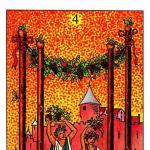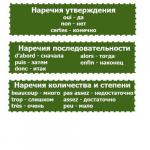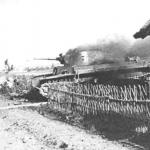" Trees
Gardens and dachas of the new wave - stylish cottages, with a comfortable area for residents to relax, surrounded by a beautiful landscape. A traditional dacha, the main function of which is harvesting, also necessarily includes a recreation area, lovingly decorated by the owners. It is for the spectacular design of a backyard area, a beautiful lawn, a children's playground, that ornamental plants and trees are needed, which are worth talking about in detail.

In addition to the natural aesthetic function of giving a person enjoyment of the beauty of nature, ornamental trees and shrubs are used by gardeners and designers to solve purely practical problems. Visual expansion of a too narrow or very small area. Decorating outbuildings, strengthening sloping areas and screes. Zoning the site, creating dividing screens between the vegetable garden and the garden area. Protecting the individual space of a small dacha from prying eyes, without erecting a fence.
Popular ornamental trees in the garden and country house
The current trend in gardening is a beautiful, fruit-bearing garden that does not require enormous physical effort to care for and maintain its decorative appearance. The beauty and unpretentiousness of trees is a priority; the practical benefits of plantings fade into the background. This explains the popularity of new forms of fruit and forest trees presented by modern selection:
- compact standard trees with a spherical crown;
- dwarf forms fruit and forest trees;
- weeping forms;
- columnar hybrids familiar trees.
An interesting novelty is the use of forest trees to decorate a summer cottage. For example, hornbeam seedlings are sold by nurseries at bargain prices. Hornbeam is great for creating hedges, decorative backdrops and walls.

To create spectacular compositions and edging lawns, trees of different heights are used:
- tall (up to 6 m);
- medium tall (up to 3 m);
- low-growing and dwarf trees (up to 1.5 m).
Tall trees form a backdrop(wall, or focal point), which is complemented by lower trees and shrubs. The undersized ones form the foreground of the composition. Trees can be decorated with gravel, located on an open lawn, solo, or combined into relief, multi-tiered groups.
The tallest ones are planted in the background, then the middle ones. Low-growing trees and shrubs are located in front.
Recognized leader - coniferous trees
Mature plants require virtually no care. Coniferous plants are decorative all year round, including winter. At the beginning of spring, many species bloom with bright lilac candles, reminiscent of Christmas tree decorations.. Then comes the time of active growth, the young shoots are much brighter than last year’s branches. During this period, all coniferous trees look especially elegant.

Spruce grows well in marshy soils, this is especially true for the Moscow region. Pine is drought-resistant, tolerates pruning well, which allows you to vary its height and decorative shape. For low hedges and walls, we can recommend yew. Yew holds its shape well and does not require significant pruning.
Tui
The unpretentious thuja can be safely chosen as the main decorative element of the garden, which will unite the plantings with a single design. Thujas of different varieties will fit perfectly into a composition with low-growing shrubs, variegated and flowering trees.
In the nursery you can choose varieties of pyramidal, ellipsoidal, or spherical shape. A garden wall made of thujas planted in a smooth line looks very interesting. This allows you to create an unusual twist on even a standard summer cottage.
For the middle zone, varieties and hybrids of Western thuja are recommended. The unpretentious variety Brabant is suitable for forming walls and scenes. A single thuja will grow wide; planting a thuja too close (after 0.5 m) will form a wall that is too low. The optimal distance between seedlings of the Brabant variety is 1 m. An interesting variety is Thuja Wagner, which has a round shape and is shorter in height. Thuja loves showering, spraying, sprinkling.
Decorative maples
The most popular is maple Canadian, Sycamore, Norway maple with burgundy foliage. They are a great solo plant on an open lawn and are good in compositions and against the backdrop of hedges.
Norway maple or sycamore burgundy color
Like most plants with brightly colored leaves, ornamental maples prefer full sun. In the shade, the natural color will fade. Maple prefers fertile soil with neutral acidity. Young seedlings should be covered for the winter. An adult plant of a frost-resistant variety will no longer require this.
Exotic for lovers
Magnolia
It can be formed as a bush, but it can also grow into a full-fledged tree with a picturesque crown. Blooming magnolia is an exotic sight; most varieties have a delicate, vanilla-citrus aroma. Magnolia is strewn with large flowers (bud length up to 12-15 cm). The color scheme and shape of the opened flower differs quite radically among different varieties of magnolia.

The whimsical nature of magnolia is greatly exaggerated; for successful cultivation it is enough to follow a few rules. When planting magnolia, special attention should be paid to the root system and the choice of planting site. You need to buy magnolia with a root ball (in a plastic container), preferably in a nursery or garden center. When planting, try not to injure the roots of the seedling. Magnolia loves bright sun and does not tolerate drafts and winds. The optimal planting location is under the southern wall of the house or any outbuilding. It does not like calcareous soils, so such lands must be acidified with peat. There is no need to care for an adult plant, only minimal sanitary pruning. For growing in gardens in the middle zone, deciduous forms of magnolia and corresponding hybrids are recommended.
Young seedlings, even frost-resistant varieties, should be covered for the winter (mulch the roots and cover the crown with agrofibre).
Sakura
The Japanese relative of the familiar cherry is famous throughout the world for its magical blooms. The growing conditions for sakura and magnolia are identical. Sunny place without drafts; neutral or slightly acidic soil. Like ordinary cherries, sakura will require seasonal spraying against pests, abundant watering, and significant pruning.

It is not necessary to buy sakura; it reproduces well by cuttings. This is much cheaper than buying a seedling. In August, the cuttings are grafted onto a traditional cherry (or sweet cherry) using the budding method (with an eye, a bud).
Decorative forms of fruit trees
The familiar apple tree has many decorative subspecies that bloom more abundantly than ordinary apple trees. Blooming with scarlet flowers, the Ola apple tree is simply filled with flowers so that the branches are not visible.
Apple tree color Ola
Ornamental varieties are grown using familiar agricultural techniques familiar to gardeners for caring for traditional apple trees. Fruits - small (paradise) apples decorate the garden until late autumn. Yellow, red, purple - look great on branches. They attract birds to the garden, a modern option for a natural solution to pest problems. Apples of paradise make original jam. Especially interesting are the weeping forms, with variegated and colored leaves.
Decorative shrubs in landscape design
Shrubs in the garden technically perform the natural function of undergrowth. From an aesthetic point of view, shrubs harmoniously complement garden trees and flower beds, performing the role of middle management. This is a large class of diverse plants; let’s focus on especially popular species.
Junipers: type and variety of bushes
Emphasized decorativeness, a wide variety of shapes and varieties, the names of the most common are given below. By releasing phytoncides, junipers significantly purify the air. In sunny weather, a healing aroma hovers near such a plant.. A common advantage of junipers is frost resistance. Bath lovers will benefit from young juniper branches, which are added to bath brooms for aroma.
Variegata

Recognized varieties include juniper Variegata. Flat, with scaly azure needles and contrasting sand tassels at the end. The shrub is shade-tolerant, but in a sunny place the decorative tassels of Variegata will be brighter. An adult plant on a sufficient area will look like a lush flower bed.
Cossack

An unpretentious plant of smoky color, prefers light soils, looks great in a composition with variegated hostas, regular and tree peonies. Loves loosening and sprinkling of branches. When transplanting, the hole should be 2 times larger than the root ball. Junipers do not resist pruning, although they do not require obligatory pruning.
Between the bushes of the Cossack juniper there should be at least 1 - 1.5 meters. In adulthood it is a spreading, lush bush.
Rock Sky Rocket

Tall blue juniper - Rocky Sky Rocket. In diameter up to 1 meter, in height up to 7 meters. It looks like a slender tree, vaguely reminiscent of a cypress.
Glauka

Low juniper Glauka (up to 30 cm), can grow up to 3 meters wide. The powerful root system of this plant allows, if necessary, to strengthen the slopes. This is a suitable plant for the foreground of a garden composition.
Mint Julit

The fastest growing medium juniper is Mint Julit, reaching 3.5 m in width, up to 1.5 m in height.. Blue Carpet is an active aggressor and occupies a vast space. It responds to pruning with increased growth. This must be taken into account when planting, and can be used for your own purposes.
Barberry - adding bright accents
The interesting shape of the bush, delicate branches, bright foliage inherent in various varieties allows barberry to lead among colored shrubs. Blooms actively in spring. The crown is purple, red, lilac, light green in the summer, incredibly transformed in the fall. This is a real carnival of colors, from lemon to wine-colored foliage, scarlet clusters of fruits. Barberry berries are an excellent seasoning for pilaf and meat dishes.

Barberry looks great in single and group plantings. A front garden, an alpine hill, edging meadows - all these compositions can be successfully complemented by barberries of your favorite variety and color. Barberries of different heights (from 30 cm to 1.5 m) can be interestingly displayed in a prefabricated mixborder. Thunberg barberry is good in combination with coniferous plants. The low-growing cushion-shaped barberry Green Carpet is used for rocky compositions in the Japanese style.
It grows well in an open, sunny place and is not picky about soil. Does not tolerate stagnation of ground inputs When planting, barberry should be provided with a high-quality drainage cushion.

Low-growing shrub (up to 80 cm) in looks very exotic, blooms profusely with orange-red flowers. In summer and autumn it is decorated with fruits resembling apples of paradise. Used for flower beds and rose gardens.
Japanese quince grows well on light sandy loam soils and loves well-lit places. The housewife makes excellent jam from the fruits.
Red viburnum
A familiar shrub that never ceases to delight with its beauty and healthy berries. Viburnum is very good in bloom; in the fall it turns purple-yellow, the red clusters of berries glow in the sun.

Viburnum loves shady places, the bush can grow quite extensively. This property of viburnum can be successfully used to decorate outbuildings and blank walls of barns. Likes good watering, the soil for planting is mixed with humus (1×1). The ground under the viburnum bush should be mulched with tree bark, this will help the moisture-loving plant to develop.
It grows wild in central and southern Europe, North Africa, the European part of Russia, mainly in its middle part and in Asia Minor. Rarely found in the west and north of Russia. Viburnum can be found in Central and Western Siberia, as well as in the eastern and northern regions of Kazakhstan. Viburnum viburnum does not grow in Central Asia and the Far East.
Familiar from indoor forms, the large-leaved garden hydrangea is a godsend for lovers of bright, actively flowering plants. Large inflorescences (12 - 15 cm) bloom in July and remain on the branches until autumn. An adult wisteria bush is not tall (up to 1 m), it can reach two meters in diameter, this must be taken into account when planting. Large inflorescences come in white, greenish, crimson, pink and even blue.

Hydrangea loves well-lit places, but direct sunlight is harmful to it. You will need moist, slightly acidic soil, abundant watering, and fertilizing. When planting, peat, sand, and coniferous forest soil are added to the soil mixture. By feeding hydrangea with iron supplements, amateurs achieve bright blue coloring of hydrangea inflorescences. It is advisable to mulch the tree trunk circle with pine needles and use slightly acidified water for watering. Hydrangea should be covered for the winter.
An interesting new product: columnar fruit trees
Compact, productive trees, strewn with fruits of the usual size, have charmed many gardeners. Columns bear fruit in the second year, take up little space, and are easy to care for.. The lifespan of such a tree is up to 15 years, in contrast to the usual longevity of ordinary trees of fruit and stone fruit crops.
What types of columnar trees are there?
Columnar apple tree is a low-growing, dwarf (relative to standard) standard tree. Proven, high-quality varieties - Arbat (red apple of medium ripening), Bolero (winter), Gin (summer variety).
Seedlings of columnar trees of the latest selection are available for sale.: plums, cherry plums, pears, peaches. The main problem is the instability of the variety. Dying of lower branches, changes in the shape of the crown (formation of a “broom”), freezing of growth buds, degeneration of the variety. There is outright fraud by sellers. If you decide to grow colonies, buy adapted seedlings from trusted regional nurseries.
At the moment, only the columnar apple tree can boast a large number of varieties of sustainable selection. Other column-shaped new items can be purchased only at your own peril and risk.
Features of planting and caring for fruit trees
Columns are very convenient for processing and maintenance, organizing drip or spot irrigation. The height of an adult fruit tree is about 1.5 m; it is grown using conventional agricultural techniques, like ordinary fruit and stone fruit trees.. Depending on the variety, seedlings are planted at a distance of 0.4 - 0.7 m from each other. The distance between rows is 2 - 2.5 m. Seasonal pruning, pest control, fertilizing, and loosening of the root circle will be required.

After planting a one-year-old seedling, the plant will show its variety in the first year. To do this, leave 2-3 flower ovaries on the tree; it is better to remove the remaining flowers in the first year. The seedling needs strength to adapt to a new place and form a healthy root system.
Selection does not stand still; popular varieties are constantly being improved. Whether to experiment with original new products or choose a decorative variety that has been proven over the years is a constant temptation for the gardener. Based on your taste preferences, you can choose an original decoration for your favorite garden.
The nursery offers the following types and varieties of decorative cherries:
Finely serrated(sakura):
- tree up to 10 m, blooms up to 7 days, profusely, double flowers, color from bright pink to white. The color of the fruit is black.
- Kanzan - up to 10 m, blooms in May. The flowers are double, fragrant, carmine-colored, 6 cm in diameter.
- Kiku Shidare is a small tree, up to 3-5 m with a weeping crown. Pink double flowers.
Ordinary– height 3 - 7 m. The flowers are white, fragrant, in umbellate inflorescences. Blooms in late April-May.
Incised leaf(sakura) Fabrewary Pink– up to 4m. The flowers are white-pink double. Good winter hardiness, but requires trunk cover. Blooms from March to April.
Ferruginous Rosea Plena– up to 1-1.5 m, winter-hardy. The flowers are densely double pink. They bloom to leaves in April-May.
More detailed information can be found on the page of each variety. The catalog of varieties of decorative cherries is constantly updated, stay tuned for changes.
Features of care
During growth and during the formation of buds and ovaries, the plant needs additional watering. The rest of the time, normal soil moisture should be maintained. Feeding requires potassium, nitrogen and phosphorus. If the soil is poor, organic fertilizers are applied. Pruning is done in the spring: dry and some old thick branches are removed so as not to thicken the crown. In the spring after flowering, treat the crown with nitrophen. Before the onset of frost, the grafting site and trunk are tied with covering material, the trunk and large branches are tied with agrofibre.
Terms of purchase and delivery
The cost of decorative cherry seedlings is from 2900 rubles.
Each seedling is sold in a special container with soil, so it will be easy to transfer it into the ground along with a lump of earth. Our specialists will help you with the choice of variety, fertilizing and other necessary conditions.
Delivery of seedlings can be carried out either by us or by pick-up.
We all want to grow fruits and berries on our plot. But what to do if the climate, frankly speaking, is not mild?!! Dear friends, I offer you a list of fruit, as well as ornamental trees and shrubs of frost-resistant varieties.
Frost-resistant shrubs and trees.
Very frost resistant (up to -35…-50°)
Trees: downy birch, common and Siberian spruce, Daurian and Siberian larches, Siberian cedar, aspen, balsam poplar, common juniper;
Shrubs: scarlet hawthorn, red elderberry, Siberian dogwood, yellow acacia, dwarf cedar, silver oleaster, mountain pine.
Frost-resistant
(up to -25…-35°)
Trees: Canadian and Engelmann spruce, prickly and Tien Shan, white willow, elm (elm), English oak, Norway maples, small-leaved linden, metasequoia, Manchurian and gray nuts, common rowan, Weymouth pine, common bird cherry, common ash; Shrubs: common hawthorn, Tatarian honeysuckle, serviceberry, common viburnum, rose-wrinkled viburnum, common lilac, western and eastern thuja.
Moderately frost-resistant
(up to -15…-25°С)
Trees: white acacia or black locust, honey locust, beech, hornbeam, yew leaf, magnificent catalpa, horse chestnut, field maple, silver, large-leaved and Crimean linden, Japanese sophora, yew berry, cedar (in short cold weather), Arizona cypress, pistachio, white and black mulberry, maple-leaved sycamore, gingko, pomegranate, rosemary; Shrubs: boxwood, cherry laurel, common privet, Japanese quince, deutzia, viburnum, angustifolia, golden mackerel, spirea, mock orange or jasmine, rose hips.
Well, just in case, a list of non-frost-resistant varieties:
Non-frost-resistant
(up to -10…-15°С)
Trees: Babylonian willow, common cypress, cedar (in prolonged cold weather), paulownia, eucalyptus, maritime and Himalayan pines, Italian or pine, evergreen sequoia, plane tree or eastern plane tree; Shrubs: large-leaved hydrangea, wisteria, fragrant olive, yucca.
Least winter hardy (not lower than -10°C) subtropical tree species - palms, evergreen deciduous and some conifers.
Frost-resistant fruit.
Apple tree. The ancient Russian varieties of folk selection are best adapted to harsh winters: Grushovka Moscow, Antonovka vulgaris, Babushkino, Cinnamon striped, Korobovka. Gardeners were also pleased with some varieties of selection from the Soviet period - Bessemyanka Michurinskaya, Brusnichnoe, Iulskoe Chernenko. After the crushing frosts of 1978/79. gave their usual abundant harvest of the variety Early Grushovka, Autumn Joy, Russian Woman, Young Naturalist, Cypress, Student.
BROWN STRIPED
Pear. The most winter-hardy varieties are Lada, Chizhovskaya, Cathedral. Noteworthy variety Veles.
 VELES
VELES
Plum. The most cold-resistant plum varieties Ussuriysk And Canadian– they can withstand frosts down to –40...–45 °C, but, unfortunately, they freeze slightly in light frosts after a thaw. Of the domestic plum varieties, the most hardy Skorospelka red, Hungarian Moscow, Blue gift, Interesting, Kantemirovka and Alexy - winter-hardy, self-fertile, productive late-ripening plum variety.
 BLUE GIFT
BLUE GIFT
Cherry. For the Central region, the following varieties of common cherry are recommended: Molodezhnaya, Memory of Enikeev, Rastorguevskaya, Assol, Bulatnikovskaya, as well as those obtained from steppe cherries Malinovka, Shchedraya, Shakirovskaya and Japanese cherries Rusinka.
 YOUTH
YOUTH
Cherries. Most hardy Bryansk pink- productive variety of late ripening cherries, Iput, Revna, Fatezh, Tyutchevka. More resistant to spring frosts Fatezh and Italian. Leningradskaya black– medium-ripening cherries, high-yielding variety.
 ITALIAN
ITALIAN
When to plant fruit trees and shrubs.
Theoretically, trees can be planted all year round, as long as the ground is not frozen. The most important thing for a planted tree is to have as much contact between the roots and the ground as possible. If the soil is frozen, it will not be compacted enough to allow this contact. If the roots of the tree hang in the void, it will not be able to replenish the moisture evaporated by the above-ground part. After all, the fact that trees “sleep” in winter does not mean that they do not lose moisture. If you plant a tree in mid-summer, for example, the biggest problem will again be increased evaporation of moisture, which, however, can be compensated for by frequent watering.
Plants with an open root system can be planted in the spring from the moment the soil thaws until the buds swell (this is only 10-15 days), in the fall from the beginning of mass leaf fall until the onset of frost. But is it really necessary to plant in the fall?? If the winter is exceptionally cold, planted trees may freeze. In addition, they can be damaged by heavy snowfall, ice, wind and other weather disasters. In autumn, planted trees can be damaged by rodents or they can simply be stolen if your garden is left unattended during the winter. At the same time, there are also advantages to planting in autumn - in autumn there is a wide selection of planting material, since it is during this period that nurseries begin selling seedlings. If you plant trees in the fall, one watering will be enough; coolness and frequent rains will take care of your pets without your participation.
What about spring planting? When planting in spring, it is necessary to water the seedling twice: at planting and a day later, loosen the soil and cover with mulch. Next, you will also have to water the planted tree frequently, especially if the weather is hot or windy.
If you are late with spring planting, the planted tree's chances of survival will be significantly reduced. If the tree has not yet begun to grow properly, but sap flow has already begun, then it can only be removed by providing special care, which not every amateur gardener can do.
In the spring, the market for planting material is poor - much is sold out in the fall.
However, during the winter you have the opportunity to prepare theoretically, draw up a planting plan, on the basis of which you can order seedlings - there will be no hasty decisions. If you plant trees in the spring, they get one more year of growing season - if planted in the fall, you would have a harvest a year later.

Apple trees, pears and stone fruits are planted as early as possible in the spring; seedlings of fruit bushes are planted even when the buds have already bloomed a little. Seedlings in containers are planted throughout the season, from mid-April to mid-November. Summer planting of leafy seedlings from containers is best done in cloudy, rainy weather.
The general rule when planting all fruit seedlings is: Before planting, the container with the seedling must be immersed in a container of water for 1-2 hours so that the earthen ball is saturated with water. Planting depth is also important. The root collar of the seedling should not be buried.
When planting, the soil around the seedlings is compacted, and earthen rolls 10-15 cm high are placed on top along the contour of the planting hole, and regardless of the weather, they are watered abundantly (2-3 buckets of water for each plant). After watering, the hole is mulched with a layer of peat, compost or old leaves. This will prevent moisture from quickly evaporating and a crust from forming on the surface of the soil.

After planting (after 7-10 days), water with a root formation stimulator and carry out foliar feeding. Epin (7-10 drops per glass of water) and zircon (1 ml per 10 liters of water) give good results. After weighing all the pros and cons, choose the most suitable time for you to plant trees. Be sure to take into account local weather conditions and features.
Good luck in your endeavors, dear gardeners!
Can anyone tell me the varieties of sweet cherries that grow on your site? I would like to know the different opinions of experienced gardeners.
By the way, leaving comments is now easier - no need to enter e-mail, Just a name is enough! We will be grateful for your comments! We read everything. We will answer as soon as possible!
Central Asia (Tien Shan, Pamir-Altai)
Habitat:
forms extensive thickets, mainly on the southern slopes of the mountains at an altitude of 900-1000 m
Sizes and growth forms:
life form:
bushdeciduous
- 1-1.5 m;
- in Moscow - about 3 m
crown diameter:
equal to height
crown shape:
round, thick
Growth rate:
grows slowly
The soil:
pH:
slightly acidic. neutral
mechanical composition of the soil:
sandy soils, loamsPlanting and propagation:
optimal planting times:
methods of reproduction:
seeds, green cuttings, shootsFeatures of seed propagation:
seeds are sown in autumn or spring after 3-6 months of stratification at +1+5°C
vegetative propagation:
more than half of the cuttings take root without treatment with rooting stimulants
Care:
Trimming:
sanitary
Winter hardiness:
main view:
in the middle zone the ends of annual shoots freeze slightly
Shelter for the winter:
not required
Decorative:
Decoration season:
Spring Summer AutumnPeak decorativeness:
during the flowering period
Decorative properties:
crown shape, leaves, flowers, fruitsBranches (bark color, shape):
branches are brown-gray, one-year-old shoots are yellowish-gray, young shoots are pubescent
Leaves:
alternate, lanceolate or narrowly obovate, with a narrow wedge-shaped base and a pointed apex, sharply finely toothed, 4-25 (30) mm long and 0.9-2.5 mm wide, on petioles 1.5-2 mm long. with subulate, pinnately dissected stipules at the base longer than the petioles
Summer color of leaves (needles):
dark green
Flowering time:
- May June;
- in Moscow it blooms from the last ten days of May for more than 10 days
Color spectrum:
Flowers:
white, simple, five-petalled, up to 1.5 cm in diameter
Inflorescences:
flowers are collected in groups of 4-6, less often 1-3
Fruit:
dark red non-succulent drupes, spherical or ovoid, 5.5-8 mm long, at the apex and base with a sparse network of grooves
Fruiting dates:
- June July;
- in Moscow the fruits ripen at the end of July, not annually from the age of 4
Peculiarities:
undemanding, resistant to urban conditions, wind resistant
Planting type:
Planting type:
hedge, group, slope strengthening- needs a warm, protected place;
- interesting for hybridization to impart drought resistance traits
Among the large number of different plants growing in gardens and parks, one of the most famous is the cherry. A tree familiar to many since childhood and growing on the territories of three continents.
Cherry is a tree or shrub, the height of its branches can be from 2 to 7 meters. The flowers are painted white or pink and collected in half-umbrellas or 1-2 in a bunch. The spherical cherry fruit in the ripe stage acquires various shades of red, from light to brown-dark. The fruits are juicy drupes, edible, and have a mainly sweet and sour taste. The green leaves have an oblong-oval shape. When blooming, the flowers smell pleasantly.
Cherry is a tree or shrub that belongs to the Rosaceae family. This is a deciduous plant species, therefore it is used for decorative purposes only as a spring accent. Many varieties and hybrids have been bred, the height of which does not reach 1.5-2 meters, with beautiful flowers, sometimes velvety, and a pleasant aroma. Cherry, a tree or bush, grows quickly and, due to the density of flowering and decorativeness, is often used in landscape design of gardens. In nature it reproduces by root shoots and seeds. In a cultivated form, it can only be propagated by grafting.
Types of cherries

There are about 150 different species in the cherry genus, which are distributed throughout Europe, Asia and North America. These are mainly domestic cultivars that were bred by breeders. Wild cherries are also found in nature, of which there are many species and varieties.
Common cherry
This is a cultivated species of cherry, a tall tree with a wide crown and spreading branches. Its bark is shiny dark. The leaves are oblong-oval, pointed at the ends, dark green on top and slightly lighter on the underside. The flowers are located on long peduncles and can reach up to 2.5 cm in diameter. The petals of this type of cherry are white in color and have a pleasant fragrant smell. The flowering period lasts about 3 weeks. The fruit of the cherry is ordinary round in shape and has a sweet and sour taste. This species is widely distributed in Russia and some European countries. This is due to the fact that the common cherry is very unpretentious in care, frost-resistant, grows well in partial shade and tolerates dry summers well. It has many hybrids, which are often used for decorative purposes.
Steppe cherry
Steppe cherry tolerates frosty winters well; therefore, it can most often be found in the north of Russia and in mountainous areas. This type of cherry is a low-growing tree or shrub that branches heavily and creates a large crown. On erect branches there are small, dark green, shiny leaves. Their shape is oblong-oval, pointed at the end. The roots grow 3 meters from the tree and are located shallow in the ground. The flowers of this type of cherry are small and collected 2-5 pieces in a bunch on the branches, painted white. The fruits are small, juicy, sour in taste, and can be red, pink or burgundy. The period of full ripening is approaching the end of summer or beginning of autumn.
Felt cherry

Felt cherry is a tree or shrub that has a large spreading crown with a small height, approximately 1-3 meters. The homeland of this species is China, so the second name is Chinese cherry. It can be used both for decorative purposes and as flowers. The flowers are densely and beautifully arranged on the branches. Its advantage is its early flowering, which is how it decorates gardens that still have bare branches. The leaves are small, oval-shaped, with jagged edges. They are pubescent on the underside, which creates a velvety effect on the entire tree. The branches are thick with rough bark and have a gray-brown tint. The flowers are small, pinkish-white in color. Felt cherry, a tree or shrub, tolerates not only winter frosts, but also spring colds. The cherry fruit is small in size, from red to almost black, sweet, juicy. The seed is small and does not separate from the berry. After ripening, felt cherry fruits can remain on the branches for a long time without losing their properties.
Sakura, or Japanese cherry tree

The Japanese cherry tree, or sakura, is more than fruit-bearing. Its homeland is Japan, where various varieties grow in all regions. Every year, local residents celebrate the arrival of spring with the beginning of cherry blossoms. The tree grows up to 4 meters in height, its crown is spreading, umbrella-shaped, and can also reach 4 meters in width. The branches are long and cascading. The leaves are narrow, ovate-shaped, and pointed at the ends. In summer they are bright green, and by autumn they turn yellow. The flowers are small pink, each of them is located on a petiole. Flowering period is mid and late spring.
sand cherry
Sand cherry is native to North America. Just like Japanese, it is used to decorate gardens and parks. Sand cherry is a shrub whose height reaches only 1.5 meters. Its crown is wide, its branches are spreading, thick, and reddish in color. The leaves are oval-shaped, oblong and pointed at the end. In summer they are dark green in color, and by autumn they turn bright red, which gives the cherry bush a special charm. The flowers are small, up to 1.5 cm in diameter, bloom in late spring. The petals are white, and the fruits are dark, almost black.
Cherry pruning
Cherry trees require annual pruning to rejuvenate trees and bushes and remove diseased and dead branches. If the question arises whether a cherry is a tree or a shrub, the answer can be simple: whichever species and variety you choose, this type of plant will delight you every year with its flowering and fruits.
Bush cherry pruning

Bush cherry branches tend to grow wildly, so they need to be pruned annually. This is done with skill, since cherries react worse than other trees and bushes to pruning. This process is carried out the next year after planting. The period must be chosen when the bush is still in winter sleep. This could be the end of February or the beginning of March.
When pruning, it is recommended to leave a standard 30-50 cm from the ground. In the first year, pruning leaves 5-7 strong branches, which are located at a distance from each other and directed in different directions. In the second year of pruning, all branches that are directed to the center of the bush are cut out. During the spring-summer period, green shoots will appear on the trunk, which must be cut off immediately. If the bush is neglected, then such shoots are removed during spring pruning of the bush.
With annual pruning, a bush is formed and branches that grow inward are removed so that the bush is not very dense. Dried and dead shoots are also removed, and young ones are left instead for replacement. Bush cherries often develop root shoots that should be removed by pruning just below ground level. If this is done higher, then a new bush will form from such shoots, and the shoots will begin to branch.
Tree pruning

Like all trees, it occurs during the dormant period. This is the end of winter or the beginning of spring. This process is tied to weather conditions in the cherry growing region. When pruning trees, dry, weak and diseased branches are removed, and the cut areas are processed. Large main branches can also be removed with a saw if disease is detected. This way you can save the entire tree by removing the bad branch.
Care and reproduction
Cherry is a tree or shrub that does not require special knowledge or specific care. Timely pruning, fertilizing, watering - these are practically all the procedures necessary for the good development and growth of cherries.
Care
Cherry in the garden prefers to grow in a bright place where the sun warms up well. The soil must be fertile and well-permeable to moisture; stagnation of water has a bad effect on the life of the entire tree. Also, the soil must be neutral and fertile; in other types of soil, cherries grow and bear fruit much worse.
Already in the 2nd year of a tree’s life, it must be fed in the spring with mineral fertilizers. If the soil is empty, then humus must be added.
A cherry tree, bush or tree, tolerates drought well, so it should be watered moderately, and after the fruit begins to ripen, reduce watering or remove it.
All types of cherries that grow as trees must be covered with lime 50-70 cm from the ground every year in spring. This protects plants from pests and various infections.
Reproduction
Spring is the best period for planting cherry seedlings. But since the growing season of this type of plant begins very early, the purchase must be made in the fall, after the leaves have fallen, and the seedling must be buried on the site.

For planting, it is necessary to dig a hole with a diameter of about 40 cm and a depth of about 50-60 cm. If necessary, it is expanded to such a size that the roots of the seedling are free in it and do not rest against the walls. Mix some of the soil with humus and nitrogen fertilizer and pour it into the bottom of the hole. The seedling is placed on top and sprinkled with earth, then filled with water. In this case, it is necessary to ensure that the young tree does not go deep and the root collar remains 1-2 cm above the ground. It is also recommended to mulch the young seedling for additional moisture conservation.
Those that grow as bushes must be planted at a distance of 2-2.5 meters from each other, so that the branches do not intertwine with each other and do not interfere with others. Tree varieties that have a large spreading crown are planted at a distance of 3-3.5 meters. It is advisable to leave plenty of space for trees so that they do not shade each other.
It occurs with the help of root suckers and cuttings, but such seedlings must be grafted to obtain the variety. Without this, a wild cherry tree will grow from the tree. But this rule applies only to previously grafted plants. Root shoots of varietal cherries produce excellent seedlings that make good fruit-bearing trees.
Useful properties and applications
Cherry (trees and shrubs of any kind) has many beneficial properties and qualities not only in the fruit, but also in the branches, foliage and even in the petioles of the berries.
Cherry fruits improve appetite and have dietary properties, and their syrup is often used in pharmaceuticals. It is also useful to eat berries with low hemoglobin. They contain substances that help normalize blood clotting.
Tree sap, called cherry glue, is used for treatment. It contains useful substances such as pentose sugar, galactose, and arabinose. Cherry glue envelops the walls of the stomach and helps with inflammation of its mucous membrane.
Cherry is often used in folk medicine, for example, the root of the tree is used to treat ulcers. The fruit pulp and juice are used as an antiseptic. And if the juice is mixed with milk, then inflammation of the joints can be treated.
A decoction of the stalks is also often used for bloating and diarrhea. This recipe is known in almost every family.
Application on the farm
Cherries are eaten raw. They are used to make tinctures, prepare compotes and jams, and add them to baked goods. Such berry trees can be found in almost every garden in Russia, Ukraine and Belarus. Cherry is a tree or shrub, a photo of which can be easily found in any botanical book, and can also be viewed in this article.



















